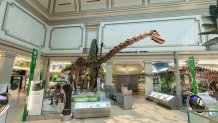It's been a renovation five years — or perhaps billions — in the making. The Smithsonian's National Museum of Natural History has reopened its dinosaur and fossil hall, drawing to a close a project that began in 2014.
Now renamed The David H. Koch Hall of Fossils — Deep Time, in honor of a $35 million gift from the billionaire, the exhibit will display more than 700 specimens, including dinosaurs, plants, animals and insects, some never before displayed at the museum.

Among the exhibit's many fossilized stars is a Tyrannosaurus rex, first discovered 30 years ago in Montana and on loan to the Smithsonian for 50 years from the U.S. Army Corps of Engineers.
"It's got a five-foot head; it's got six-inch teeth; it's one of the largest carnivores that ever lived," Matthew Carrano, curator of dinosauria at the museum, said of the T. Rex's draw during an appearance on TODAY last week.
"Its home is here in the United States, so we kind of feel like it's our ambassador," he said.
[[510162801, L]]
Local
Washington, D.C., Maryland and Virginia local news, events and information
The T. Rex won't be displayed on its own; rather, it will demonstrate its sheer size and power while looming over a Triceratops, its teeth poised to snap. It's a unique and visually arresting pose that the Smithsonian Magazine says has never been done before.
"It allowed us to do something no one's done yet with a T. Rex: these two animals directly engaged," Carrano told the magazine last year.

From Deep Time to the Future Ahead
"We want people to walk into that exhibit and have their jaws drop," said Scott Wing, curator of fossil plants for the museum.
The new hall welcomes visitors to figuratively travel through time, beginning 3.7 billion years ago at the start of Deep Time — the name scientists gave to the long period before human history began — and ending in the future, to examine the impact humans have on the Earth's climate and the fate of life on Earth, according to a press release from the Smithsonian Institution.
This is just one of the many themes that the museum aims to include in its renovated hall, as well as the idea that life on Earth is constantly changing. Humans, plants and animals have important connections to deep time, the museum says.
"This new exhibit will tell the story of life on Earth, but it's going to be very different than all similar exhibits around the world, because this one's not going to end in the past. This one will end in the future," Director of the Sant Ocean Hall Kirk Johnson said in a video provided by the Smithsonian.
The dinosaur hall — originally called the Hall of Extinct Monsters — first opened in 1911, a year after the museum itself. The hall was partially renovated many times over the 20th century, but the construction that began in 2014 was the first complete overhaul.
"And when we closed this hall in 2014, it was an amalgam of many partial renovations of the hall," Johnson said. "It had some cool stuff, but it really missed integrating all the science that happened over the last century."
Hundreds of new specimens will be on display, and many of the old ones have been reconditioned and reposed, Wing said.
Other renovations include a life-size prehistoric shark hanging in the new dining facilities, which are more sustainable. And the National Mall entrance is now accessible to visitors using wheelchairs and strollers for the first time in the museum's history.
Photos: Smithsonian's New Dino Hall Stars T. Rex, Allosaurus u0026 More
The museum will also have extended hours for the summer. It will be open from 10 a.m. to 7:30 p.m. every day in June (except June 20) and will keep those extended hours Thursdays through Saturdays in July and August (with the exception of Aug. 17).
The project cost $110 million, with $70 million coming from a federal appropriation for the renovations and $40 million from private donations.



